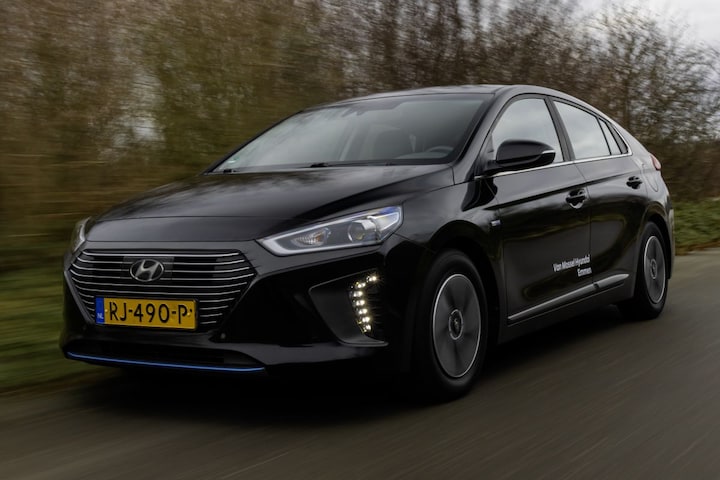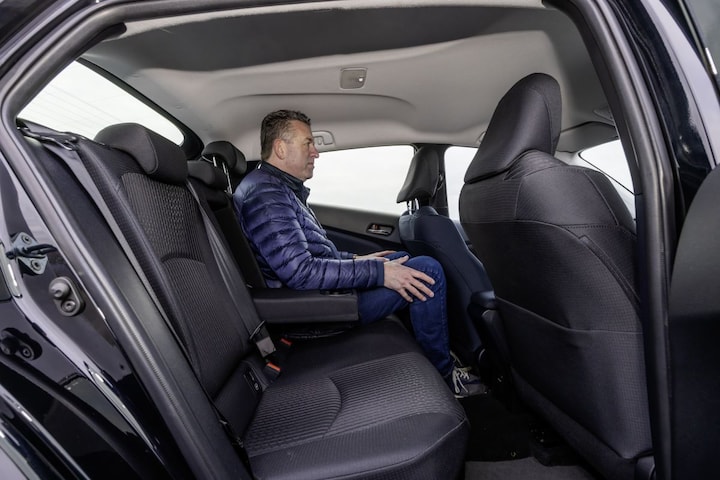Occasion double test

The Toyota Prius is a hybrid of name and fame, but eight years ago Hyundai came up with the Ioniq. You also had that as a hybrid. There are plenty of similarities between the two hybrids in this test, the most important being their drag coefficient of just 0.24. If there is one way to make a car super efficient, it is by keeping air resistance as low as possible. Whose deed.
For this comparison test between two very economical used cars, we looked for a Hyundai Ioniq 1.6 GDi Hybrid Comfort from 2018, which is for sale for €17,840 and has 103,000 kilometers on the odometer. The Toyota Prius is two years older, has fewer kilometers (74,300) and is for sale for €21,850. It is available with the Business Plus equipment.
Cd value is so important to make EV economical
What makes the Tesla Model 3 the most efficient EV on the market? Not only the underlying technology, but especially its low, smooth carriage with a Cd value of 0.21. Mercedes proved that it can be even more extreme with the Vision EQXX study model. It has a Cd of 0.17 and manages to squeeze more than a thousand kilometers from its 100 kWh battery pack. Since its birth in 1997, the Prius has always had something of a goat-wool image, even though it is just about the most efficient gasoline car in the world. Okay, a hybrid, but you fill up with gas. The Model 3 did not receive that stamp. On the contrary, we all think they are cool and progressive. Toyota has continued with hybrid technology since 1997 and now uses it in almost all models, including those of Lexus. The brand has already sold more than 24 million hybrids worldwide, no other brand has taken up this on such a large scale. The major Korean competitor has a huge lead when it comes to fully electric cars and now has a nice range of hybrids and plug-in hybrids.
Just after Toyota presented the fourth generation Prius at the 2015 IAA, Hyundai presented the Ioniq in Geneva in early 2016. Not only as a regular hybrid, but also as a plug-in hybrid and, to top it all off, even fully electric. Its appearance is clearly inspired by the body of the Prius. Not surprising, after all, the wind tunnel dictates.

Hyundai Ioniq often called the Korean Prius
Should we accuse Hyundai of plagiarism with the Ioniq? Perhaps, although the South Koreans haven’t gone so far as to call this model Secundus. Yet it is often – and quite understandably – called the Korean Prius. Technically speaking, it is in any case not a copy of the Toyota. We see a 1.6-liter petrol engine that is linked to a six-speed dual-clutch automatic transmission and, of course, an electric motor. It looks a bit smaller than the Prius and is therefore seven centimeters shorter. Also a shared appearance feature is the very flat rear window and a small, narrow window under the rear spoiler. In any case, the view to the rear is not optimal, that quickly becomes clear.

The interior looks neat and the dashboard is quite conventional in design, with a blue strip here and there and a sturdy gear lever. You don’t have to look for anything, the operation is logical. The infotainment system can be connected to Apple or Android and is therefore up to date. The knees are stuck in the back seat as soon as you are 1.90 meters tall or more. Anyone who is smaller is fine. Even the headroom is just enough. You activate the drivetrain with the start button and if you take off quietly, you drive away electrically. Give a little more gas and the four-cylinder wakes up and the Ioniq feels like a normal petrol car with an automatic transmission. It shifts smoothly and without jerking and thanks to the assistance of the electric motor, there is always enough torque.

We would describe the suspension as firm rather than comfortable, but the driving feeling is good. You feel involved in everything that happens, despite the narrow tires. If you choose the sporty mode, you get a large tachometer in front of you and the drivetrain feels even more direct and sporty. Furthermore, the Hyunda is extremely economical. The hypermilers will manage to drive more than a thousand kilometers on a tank. The South Koreans have made a good impression with this car.

Futuristic Prius: this one even more extreme
When you say hybrid, you say Toyota Prius. That started in 1997 with a rather funny-looking model, followed by the slightly more manageable generations two and three. Then issue four was released at the end of 2015, which is extreme and explicit in every way. It is the first Toyota on the TNGA platform. The faithful adepts embraced him in all his extremeness, while others may have been chilled by it. For Toyota, the aim was to build a Prius that was better than its predecessor in every respect and they succeeded. It is a futuristic car, just like the Citroën DS was in its time. In any case, it shows courage and self-confidence.

Because Toyota also installed the hybrid technology of the Prius in the Auris and the Lexus CT 200h, it faded into the background as an economy champion. This is reflected in the sales figures: in the peak year of 2009, the Dutch importer wrote just over eight thousand orders, in 2023 the counter was stuck at 64 units. Of course, that does not detract from the quality of the streamlined Toyota. The interior design is the same as that of the previous model. The instruments in the middle, a large screen and a very small gear lever. It all looks and feels very solid and no higher quality than that of the Hyundai.

There is a little more space on the back seat and the trunk is also a bit larger. The drivetrain is known and further refined. What is remarkable is the slightly lower peak power than before. Giving a lot of gas means a lot of revs, that is a well-known characteristic of a car with a CVT. If you are a bit more cautious, you will notice that the Prius still moves forward smoothly because you make better use of the electric torque. Once up to speed, on a flat road, you hear the engine speed drop further and every now and then you even drive electrically for a while. The interplay between the two engines is flawless. In combination with the fairly comfortable suspension, this makes the Prius a relaxing car that invites less smooth cornering than the Ioniq. The remote control also plays a role in this, although it is a lot better than with the Prius of generation three.

Pay attention to maintenance schedule at Hyundai
You mainly buy these types of cars based on rationale, with low fuel consumption as the main argument. With the Toyota there is also reliability, which partly explains the high purchase price. Hyundai has not yet built up that track record, but for the time being we have not read any horror stories about the brand. The Koreans provide a five-year warranty without mileage limitation, where it is important that the maintenance is carried out according to the factory schedule and by the dealer. So pay close attention when purchasing a Hyundai that is less than five years old.

Toyota goes a step further and even provides a 10-year warranty (up to 200,000 km), on the condition that the car in question is maintained by the dealer. A comprehensive maintenance history is not even necessary; As soon as this is resumed by the dealer, the warranty commences. Hyundai should do the same, this is how you keep customers on board. When it comes to equipment, there are some similarities. The Ioniq has parking sensors front and rear, the Prius only a camera. They both have adaptive cruise control and lane departure warning, the Prius even has blind spot detection and a head-up display. The Hyundai’s infotainment system has an edge due to the possibility of smartphone display. There is unanimity when it comes to fuel consumption: a neat 1 out of 21.7 on average! Optimistic NEDC values, neat practical figures. Thanks to the excellent aerodynamics, these spacious family cars can easily drive 1 in 20 and more economically. This means that your energy costs are slightly above the level of an economical EV.
Want all the figures and reviews at a glance? Then download the attached PDF from the magazine.
– Thanks for information from Autoweek.nl